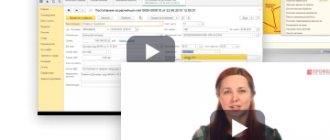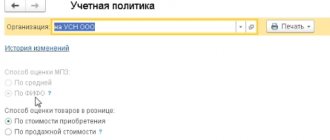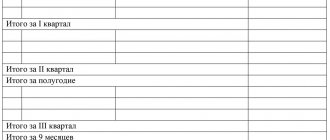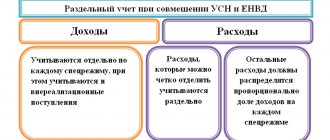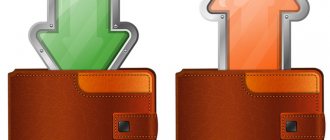Who should flash KUDiR
The book of income and expenses is kept by individual entrepreneurs on OSNO, simplified tax system, unified agricultural tax and patent, as well as organizations on the simplified tax system.
The book can be filled out manually or using an accounting service to avoid errors during registration. After the end of the next tax period - calendar year - print the book and stitch it. Also print and staple empty sections. In the absence of profit, expenses and activity in general, you will still have to sew a zero KUDiR. The book can be flashed by the individual entrepreneur himself or the director of the organization. If the company has a full-time or visiting accountant, he usually does this. A signature is placed on the last page, which secures the firmware of the book - it must be signed by the business owner.
Since 2013, certification by the tax authorities is no longer required. A new book is opened for each tax period (year).
What legislative act establishes the procedure for working with KUDiR
Work with the book is regulated by Order of the Ministry of Finance of Russia dated October 22, 2012 No. 135n “On approval of the forms of the Book of Income and Expenses of Organizations and Individual Entrepreneurs Applying the Simplified Taxation System, the Book of Income Accounting of Individual Entrepreneurs Using the Patent Taxation System, and the Procedure for Completing Them.” This is what this document points to:
- the book must be numbered and laced;
- on the last page of a laced book, indicate the number of pages in it;
- Here this data is certified by the signature of the individual entrepreneur or the director of the organization and a seal (if available).
But not a single document regulates the stitching method or provides a sample of the KUDiR firmware. Although, of course, such instructions would make life easier for everyone who deals with the book. In this situation, accountants and entrepreneurs rely on established traditions of filing documents and rely on the norms of the Federal Archive and state standards. We talked about flashing methods in this article.
Keep records of exports and imports in the Kontur.Accounting web service. Simple accounting, payroll and reporting in one service
Ana-sm.com
Despite the fact that since 2014, individual entrepreneurs using the simplified tax system do not have to submit the KUDiR to the Tax Inspectorate when submitting annual reports, we are required to have this same KUDiR for the past year.
And it must be properly formatted: filled out correctly, the pages numbered and filed, on the last page there is the inscription “Sewn and numbered (for example) 7 (seven) sheets”, signature and seal of the individual entrepreneur. I would also like to note that since 2013, a new KUDiR form has been used for individual entrepreneurs and organizations using the simplified tax system. Since 2013, the mandatory certification of the book of income and expenses by the tax authority has been abolished. However, the stitched and numbered KUDiR must be there in any case. The fine for the absence of a book for individual entrepreneurs is 200 rubles, for organizations 10,000 rubles.
If you have not yet filled out the KUDiR, then you should familiarize yourself with the instructions for filling out the KUDiR on the simplified tax system, and in this note we will talk about filing documents, and specifically how to sew the KUDiR.
How, in principle, to staple documents correctly?
Are there any general rules?
None of the authorities that require documents to be stapled in order to ensure maximum difficulty for forgery provide instructions, rules or samples on how to do this. Although, it would seem, well, take a photo of how to staple documents and everyone will be better off. After all, this must be done “correctly”, and not otherwise.
You cannot staple sheets of one document together with a stapler, nor can you glue them together. You just have to stitch it together. This can be done using a needle and thread, stitching through sheets of paper. If there are a lot of sheets, then you will need an awl, but it is more convenient to use a hole punch and a thin strip of braid instead of thread. Some sew “on the left side”, others - “at the upper left corner”.
But then everything is the same for everyone: take a small piece of paper, paste it on top of the threads / tape, then on this piece of paper, ending up on the document itself, it is written “Sewn and numbered so many
pages. Last name I.O. Signature." A stamp is placed (if any).
So, what is needed to stitch KUDiR:
- filled out KUDiR, with numbering of sheets - hole punch or needle - thin strip of braid or thread (documents are stitched with thread twice, for strength) - office glue - paper for stickers measuring approximately 4*6 cm (not thick) - pen - stamp (if available )
We make holes through all the sheets of the document, thread the ribbon, tie it on the back side of the bound document, paste a piece of paper on top, sign (the edges of the signature and seal should extend beyond the borders of the sticker paper). That's all.
For clarity, I will give two versions of the video with stitching of documents: - from the left side
- from the upper left corner
I would like to say that the ribbon sometimes makes the inspector/receiving person from the Pension Fund smile (it was noted when I had to submit the KUDiR to the tax office), but it was very convenient when returning the book “back” (in the first year they immediately returned the book to me, putting a mark, and the next year they said: come for it in 5 days) - my KUDiR stood out very clearly from the general pile and I simply pointed to it, so I didn’t have to go through the whole pile.
Order of the Ministry of Finance of the Russian Federation dated December 30, 2005 N 167n “On approval of the form of the Book of Income and Expenses of Organizations and Individual Entrepreneurs applying the simplified taxation system, and the Procedure for filling it out”:
…
1.5. The book of income and expenses must be laced and numbered. On the last page of the Income and Expense Accounting Book, numbered and laced by the taxpayer, the number of pages it contains is indicated, which is confirmed by the signature of the head of the organization (individual entrepreneur) and sealed with the seal of the organization (individual entrepreneur - if any), and also certified by the signature of an official of the tax authority and sealed with the seal of the tax authority before the start of its maintenance. On the last page of the Taxpayer’s numbered and laced Income and Expense Book, which was kept electronically and printed on paper at the end of the tax period, the number of pages it contains is indicated, which is confirmed by the signature of the head of the organization (individual entrepreneur) and sealed with the seal of the organization ( individual entrepreneur - if available), and is also certified by the signature of an official of the tax authority and sealed with the seal of the tax authority.
—
How to flash KUDiR
The book is bound to prevent tampering or removal of parts of the book. It is for this purpose that the “tail” of the firmware is sealed with a piece of paper and a seal and signature are placed partly on a sheet of the book, and partly on a paper sticker.
What you cannot do with a book: staple the sheets, glue them together, or connect them using plastic holders purchased at the nearest copy center.
What you will need to stitch the book:
- the book itself (all sections, including empty ones) - correctly filled out, printed, with numbered sheets;
- a strong and fairly thick thread or braid - even a satin ribbon of your favorite color will do;
- needle, awl or hole punch;
- paper glue;
- a piece of paper approximately 8x8 cm;
- blue ballpoint pen;
- stamp (if available).
Sew the book along the left side or the upper left corner. The length of the seam does not matter. It is only important to bring the ends of the thread or braid to the back of the document, tie them and leave a “tail” of about 10 cm to seal it with a piece of paper.
The program will fill in and print
I chose Kontur.Accounting because it is convenient and understandable to work with for those who do not understand accounting at all. Plus a reasonable price. The program will fill out all reports and KUDiR and print them, if necessary.
Vera Sergeeva, director at GreenRiva LLC (St. Petersburg)
How to sew KUDiR?
Despite the fact that since 2014, individual entrepreneurs using the simplified tax system do not have to submit the KUDiR to the Tax Inspectorate when submitting annual reports, individual entrepreneurs are required to have this same KUDiR for the past year. And it must be properly formatted: filled out correctly, the pages numbered and filed, on the last page there is the inscription “Sewn and numbered (for example) 7 (seven) sheets”, signature and seal of the individual entrepreneur. I would also like to note that since 2013, a new KUDiR form has been used for individual entrepreneurs and organizations using the simplified tax system. None of the authorities that require documents to be stapled in order to ensure maximum difficulty for forgery provide instructions, rules or samples on how to do this. Although, it would seem, well, take a photo of how to staple documents and everyone will be better off. After all, this must be done “correctly”, and not otherwise. You cannot staple sheets of one document together with a stapler, nor can you glue them together. You just have to stitch it together. This can be done using a needle and thread, stitching through sheets of paper. If there are a lot of sheets, then you will need an awl, but it is more convenient to use a hole punch and a thin strip of braid instead of thread. Some sew “on the left side”, others - “at the upper left corner”. But then everything is the same for everyone: take a small piece of paper, paste it on top of the threads / tape, then on this piece of paper, ending up on the document itself, it is written “So many pages are stitched and numbered. Last name I.O. Signature." A stamp is placed (if any).
Procedure:
- We number the pages of the book if the number is not included when printing.
- We fold the sheets in order, make holes with an awl or hole punch in the upper left corner or on the left side.
- We pull the thread or braid through the holes, form a seam and bring the ends to the back of the book.
- On the back side we tie the ends of the thread or braid, leaving “tails” up to 10 cm long.
- We bend a small piece of paper in a ratio of 1:2. The smaller part of the sheet will cover the seam on the front side of the document, and the larger part will cover the seam with the knot on the back side.
- We take the glue and paste the leaf. The ends of the thread or braid should stick out from under the leaf.
- On a piece of paper on the back of the document we write: “N pages are bound and numbered” (indicate the number of pages in your book).
- You can enter the current date.
- The manager signs so that part of it is on the KUDiR, and part of it goes on the pasted sheet.
- We put a stamp in the same way, so that part of the imprint is on the book, and part on the sheet.
It is done. After that, we keep the book in your business archive for four years.
KUDiR is easy to maintain and print in the Kontur.Accounting web service. The service is suitable for organizations using the simplified tax system, for individual entrepreneurs using the simplified tax system and OSNO, as well as for combining modes. Easily conduct accounting, pay salaries, pay taxes on time and send reports via the Internet using our service. The first 14 days are free for all newbies.
KUDiR for individual entrepreneurs and LLCs in 2021
Contains four tables (one for each quarter). Each table consists of 5 columns (columns).
COUNT No. 1. Serial number of the record.
COUNT No. 2. Date and number of the primary document confirming income or expenses.
On income:
- If funds are received at the cash desk, then the date of receipt and the number of the cash report, which is compiled at the end of each shift (formerly Z-report), are recorded. For example, 01/15/2020, FD No. 54 (report on shift closure).
- If the funds arrived at the current account, then the date of arrival and the number of the payment order or bank statement are recorded. For example, 01/15/2020 payment order No. 100 or 01/15/2020 bank statement No. 100.
- If the funds were received using a paper BSO (strict reporting form) (if, by law, the cash register can not be used), then for each such issued form it is not necessary to make a separate line in the KUDIR.
Instead, you can write down the date of the working day and issue a PKO, which lists the numbers of all issued BSOs for that day (in this case, the amount of funds for these BSOs is entered in column 4). For example, 01/15/2020 PKO No. 100. You can group BSOs only if they were discharged within one day. Note! From July 1, 2021, it is prohibited to use paper strict reporting forms instead of cash receipts. BSO should be formed using CCP. However, if the individual entrepreneur uses a deferment until mid-2021 or the business is completely exempt from CCP, then paper BSO can be used as a document confirming the calculation. - If a refund was made for a product or service, then in column 4 the refund amount is entered with a minus sign, and in column 1 the date of the actual return and the number of the payment order or cash receipt for the refund (FD number) are recorded.
Note! The point of indicating the document number in column 2 of KUDiR is to identify the operation and, if necessary, find it at any time. Previously, the shift closure report (Z-report) had a number. Now, instead of it, you can use the “fiscal document number” attribute - FD. However, each cash register has its own FD numbering. Therefore, if you have several cash registers, it is recommended that in addition to the FD, you indicate the FN (fiscal drive) details or the cash register number.
When an expense is incurred (only for the simplified tax system “Income minus expenses”), the date of the expense and the number of the primary document are recorded, which can be: an invoice, a payment order, a cash report, a sales receipt (if work without a cash register is allowed), etc. For example, 01/15/2020 FD No. 53 (return receipt), 01/15/2020 delivery note No. 55, 01/15/2020 item No. 55, 01/15/2020 FD No. 55 (shift closing report), etc.
Please note that the costs of purchasing goods for subsequent resale are recorded only after they are sold.
COUNT No. 3. Contents of operation.
This column is not too important.
Examples of filling in income:
- Receipt at the cash register. Payment under agreement No. 100/AA dated January 10, 2020 for the provision of advertising services.
- An advance was received from the buyer LLC Firma for the upcoming delivery of goods under contract No. 100/AA.
- Income received. Trading revenue for 01/15/2020.
- Refund to the buyer under agreement No. 100/AA dated 10/15/2019.
Examples of filling in expenses (only for the simplified tax system “Income minus expenses”):
- Advance paid to employees.
- Wages listed.
- Personal income tax is transferred from wages.
COUNT No. 4. Income taken into account when calculating the tax base.
Please note that when returning funds to the buyer, the amount is written in this column with a minus sign. Those. not in expenses (column No. 5), but in income (column No. 4).
COUNT No. 5. Expenses taken into account when calculating the tax base. Filled out only by individual entrepreneurs and organizations using the simplified tax system “Income minus expenses.”
In the “Help for Section I” fill in:
- on the simplified tax system “Income” only line 010 for the entire year;
- on the simplified tax system “Income minus expenses” lines 010, 020 for the whole year and lines 040, 041 (if the amounts are not negative).
How to fill out an income book for an individual entrepreneur on a patent
KUDiR on the patent has a number of differences:
- a separate book is kept for each patent;
- funds must be registered on the day they are received at the cash desk or account;
- any document that confirms payment can be used as a basis for recording the transaction;
- Cash accounting is carried out in chronological order.
An example of filling can be seen in the screenshots below:
Maintaining a book of income and expenses under the simplified tax system: rules and responsibilities
In accordance with Art. 346.24 of the Tax Code of the Russian Federation, all taxpayers who have chosen the simplified tax system must keep records of income received and expenses incurred in order to determine the object of taxation. For this purpose, a tax register is opened annually: a book of income and expenses.
The form of this register and the rules (procedure) for its completion were approved by Order of the Ministry of Finance of Russia dated October 22, 2012 No. 135n (hereinafter referred to as the Procedure, Order No. 135n).
The book can be maintained in any way (filled out manually or on a computer), but in any case, its final copy must exist in paper form, have numbered sheets and be certified by the signature of the head of the legal entity or individual entrepreneur and a seal (if there is one).
The book does not need to be submitted to the Federal Tax Service along with the tax return, but during an audit it must be presented to the inspector within 10 days (clause 3 of Article 93 of the Tax Code of the Russian Federation).
If the book is not kept or there are significant violations when filling it out that lead to an underestimation of the taxable item, the violating taxpayer faces a fine. The maximum fine is 20% of the amount of the unified simplified tax system that has not been received into the treasury, the minimum is 40,000 rubles. (clause 3 of article 120 of the Tax Code of the Russian Federation).
If a violation of the tax accounting procedure does not lead to an understatement of tax, the fine for the taxpayer will be from 10,000 to 30,000 rubles (clauses 2 and 3 of Article 120 of the Tax Code of the Russian Federation). Failure to provide the book at the request of the inspectors will result in a fine of 200 rubles. (Article 126 of the Tax Code of the Russian Federation) plus 300–500 rubles. (Article 15.6 of the Administrative Code) in the form of an administrative penalty against the head of a legal entity.
Read more about liability for tax offenses committed in the article “Responsibility for tax offenses: grounds and amount of sanctions.”
How to sew a ledger for accounting income and expenses under the simplified tax system (6%)?
Hello! We read the Order of the Ministry of Finance of Russia dated October 22, 2012 N 135n “On approval of the forms of the Income and Expense Book of organizations and individual entrepreneurs using the simplified taxation system, the Income Book of individual entrepreneurs using the patent taxation system, and the Procedure for filling them out”: 1.5. The book of income and expenses must be laced and numbered. On the last page of the Income and Expense Book, numbered and laced by the taxpayer, the number of pages it contains is indicated, which is confirmed by the signature of the head of the organization (individual entrepreneur) and sealed with the seal of the organization (individual entrepreneur - if there is one). On the last page of the taxpayer’s numbered and laced Income and Expense Book, which was kept electronically and printed on paper at the end of the tax period, the number of pages it contains is indicated, which is confirmed by the signature of the head of the organization (individual entrepreneur) and sealed with the seal of the organization (individual entrepreneur). entrepreneur - if available).
Quote (noir): Question. What to do: number them manually, leave everything as is, or can you edit it in 1C and insert the page number yourself, and then print it again? Both options are possible. As we can see from the regulations, there is no prohibition on manually numbering pages. If you have questions, don't hesitate to ask. Have a nice day and successful work!
How to keep a book of income and expenses of an individual entrepreneur
The procedure for maintaining a book of income and expenses for individual entrepreneurs is no different from the general rules.
Entrepreneurs do not indicate in column 4 of Section I of the book income that is subject to personal income tax. This is directly stated in clause 2.4 of the Procedure approved by Order No. 135n.
In section IV of individual entrepreneurs on the simplified tax system, 6% without employees reflect the insurance premiums they transferred for themselves. Those who make payments to other individuals, in this column reflect both contributions transferred for themselves in a fixed amount, and similar payments paid for employees.
How to fill out KUDiR on the simplified tax system “Income”
The taxable object affects which sections of the ledger need to be completed. When referring to “Income”, the entrepreneur indicates the information required in sections I, IV and V. Examples:
- Section I. Income and expenses
- Section IV. Tax-reducing expenses
- Section V. Trade Fee Reducing Tax
How to keep a book of income and expenses in electronic format
Most official portals with regulatory documents offer to download a file in MS Excel format for maintaining the register in electronic form. When you download it, an electronic document opens in the form of a formatted appendix to order No. 135n.
Due to the fact that the procedure for maintaining a book in electronic and paper formats is the same, there should not be any particular difficulties with its design on a computer. If an error made when registering a transaction was discovered before the book was printed on paper, it can be easily corrected. If an error was discovered when the register was printed, the correction is made on the basis of clause 1.6 of the Procedure (certified by the manager’s signature and seal (if any) with the date of the correction).
The register, which was kept in electronic format during the year, must be printed at the end of the tax period. Its sheets are numbered, stitched and sealed with the signature of the head - a legal entity or individual entrepreneur - and a seal (if any).
Sending the book to the Federal Tax Service in electronic format with a digital signature is not provided for by the specified Procedure.
How to fill out sections of the income and expense ledger
Each business transaction performed by a taxpayer using the simplified tax system during the tax period, which has an impact on the formation of the tax base, must be registered in the book. Entries are made in chronological order. Based on the results of each quarter and at the end of the year, results are compiled.
Column 4 of Section I reflects income, the list of which is contained in Art. 249–250 Tax Code of the Russian Federation. Accordingly, the operations listed in Art. 251 of the Tax Code of the Russian Federation, as well as those that are subject to income tax for legal entities or personal income tax for individual entrepreneurs. Income received in kind is reflected at the market price of the received property.
Taxpayers who have chosen the accounting object “income minus expenses” enter their expenses in column 5 of the same section (their list is specified in Article 346.16 of the Tax Code of the Russian Federation). “Simplified people” who pay tax on the object “income” indicate in this column their expenses incurred as part of the implementation of budget unemployment programs, as well as expenses that were made from funds subsidized for the development of entrepreneurship.
Section II, concerning fixed assets, is filled out by simplifiers who have chosen “income minus expenses” as the object of taxation. Section III is also completed by taxpayers working with the “income minus expenses” object, if they have losses based on the results of previous years that can be taken into account when calculating the tax for the current year.
Section IV is filled out by taxpayers who calculate the single tax on the “income” object. All insurance premiums paid are recorded here, which have an impact on reducing the amount of accrued tax.
Since 2021, the book of income and expenses has been supplemented with Section V, in which taxpayers who have chosen “income” as the object of taxation reflect the amounts of trade duty paid, which affect the amount of tax payable to the budget.
For more information about the differences in the procedure for filling out the book depending on the selected taxation object, read the material “The procedure for filling out KUDiR under the simplified tax system, income minus expenses.”
You can download the current 2019-2020 expense and income ledger form on our website.
And if you need the previous version of the register (for 2013-2017), then this is it:
How to fill out the KUDiR on the simplified tax system “Income minus expenses”
The simplified tax system with the object “Income minus expenses” involves filling out sections I to III. You also need a certificate for the first section summarizing the amount of income and expenses.
- Section I. Income and expenses
- Section II. Expenses on fixed assets and intangible assets
- Section III. Losses from previous periods that reduce the tax base
How to check the book of income and expenses in 1C
There is an opportunity to check the correctness of the book of income and expenses in the 1C: Accounting program. For this purpose, a special function “Book Filling Assistant” is provided. With its help, an accountant can run routine operations and analyze the results.
When you download the special service built into the program, you can view all accepted and non-accepted expenses. The most common mistake is the program’s failure to provide documents confirming payment of expenses incurred. And in the absence of payment, expenses cannot be taken into account (Article 346.17 of the Tax Code of the Russian Federation). You can correct the error by group re-posting all documents for the tax period.
Read about all the nuances of using this accounting program by simplified people in the article “Using 1C Accounting under the simplified tax system.”
Book of income and expenses: example of filling out in special situations
An example of filling out a book of income and expenses will help you avoid mistakes in its design. This is especially true in situations where some non-standard operation arises.
Example:
The taxpayer transferred the advance payment to the supplier using the simplified tax system, but he did not ship the goods to him, and in the end he returned the advance payment. In this situation, an entry in column 5 cannot be made when transferring the advance, since this type of expense is not specified in Art. 346.16 Tax Code of the Russian Federation. This means that the returned advance is not shown in column 4 “Income”. This is stated in the letter of the Ministry of Finance of Russia dated December 12, 2008 No. 03-11-04/2/195.
If the taxpayer receives an advance payment, this amount is reflected in income, since simplifiers are required to use the cash method. But when returning the advance payment, it is necessary to reverse the entry made earlier for the amount of the advance payment returned to the buyer.
A sample of filling out the book of income and expenses for 2019-2020 can be found on our website.
And this is a sample of filling out a book of income and expenses for periods up to 2018:
Book of accounting of income and expenses (KUDiR) in 2020
Document form:
Download KUDiR for simplified tax system
Download KUD for patent (PSN)
Download KUDiR for Unified Agricultural Tax
Download KUDiR for OSNO
The book of accounting of income and expenses (hereinafter referred to as KUDiR) is a mandatory way of maintaining tax accounting for:
- Individual entrepreneurs on the simplified tax system, PSN, OSNO, Unified Agricultural Tax;
- Organizations (legal entities) on the simplified tax system.
There is no accounting book for UTII!
You can conduct KUDiR without errors through this service, which has a free trial period.
For each tax period, a new KUDiR is opened, entries in it are kept from January 1 to December 31 of the current year.
Please note that when combining the Patent system and the simplified tax system, it is necessary to keep separate records of income and expenses, therefore, for each type of activity its own KUDiR will be opened.
The legislation of the Russian Federation allows for maintaining KUDiR in two forms: electronic or paper. At the end of the year, the electronic KUDiR needs to be printed, the sheets in it must be numbered, the book itself must be stitched and the total number of pages must be certified by the signature of the entrepreneur or director of the organization.
In order not to compromise the integrity of the book, unfilled sections are also printed and bound. Only in this form should the KUDiR be stored and, if necessary, presented at the request of a tax inspector.
Do I need to have the KUDiR certified by the tax office? No, this has been canceled since 2013.
Please note once again: KUDiR is a mandatory tax register and its absence is a gross violation of accounting rules. For such a violation, a fine of 10,000 rubles is provided. The fine is the same for both organizations and individual entrepreneurs.
Instructions for filling out KUDiR
General rules for filling out KUDiR:
1) All entries are made in Russian, in chronological order, strictly by date
2) Income and expenses are indicated in rubles
3) Only those transactions that affect the calculation of the tax base and tax amount are entered into KUDiR
4) Errors in KUDiR must be corrected on the basis of supporting documents (new invoices, acts, sales receipts, etc.). All corrections are certified by the signature of the entrepreneur or head of the organization, and the date of the changes is indicated.
Title page
There are no special requirements for the content of the KUDiR Title Page, but we recommend that you fill out the following fields:
Field "Date (year, month, day)". The start date of maintaining KUDiR is indicated.
Field "Object of taxation". One of the options “income” or “income reduced by expenses” is indicated.
Fill in the information: full name for individual entrepreneurs or name of organization for legal entities, INN/KPP, current account - if available, as well as the necessary addresses.
Section 1. Income and expenses
This is the most important section of KUDiR. Please fill it out carefully. Remember that “simplified people” - both individual entrepreneurs and organizations use the cash method of registering transactions, i.e. Income and Expenses are taken into account at the moment when they were actually received (produced).
With the cash method, what matters is not the moment when you shipped the goods (provided the service), but the moment when you were paid for it. Every advance received will be considered income! To take into account an Expense, you need not only to pay for the product (service), but also to receive this product from the Supplier. The advance payment you paid (without receiving the goods/services) is not an Expense and you do not need to enter it into KUDiR.
The “Income and Expenses” section consists of four main tables. Each table contains data on transactions for one quarter, which allows you to correctly calculate the amount of the advance tax payment.
Individual entrepreneurs and organizations with the object of taxation “income” must fill out columns 1 to 4, while those with the simplified tax system “income minus expenses” fill out all five columns.
Column 1 – write the serial number of the operation.
Column 2 – enter the date and number of the primary document. The primary accounting document is a payment order, a bank statement, a cash receipt and cash disbursement order, a sales receipt, a strict reporting form (receipt), a certificate of completion of work, a delivery note, a payroll, etc.
Column 3 – indicate the content of the business transaction. How much detail the essence of Income (Expense) needs to be disclosed should be decided by the individual entrepreneur or the director of the organization. There are no strict recommendations.
You can limit yourself to the brief wording “revenue from the sale of goods”, “advance for clearing the roof of snow IP Zimin”, “payment for shoe repair services Karimova S.Yu.” Remember that first of all, the entries in KUDiR should be understandable to you, as an individual entrepreneur (director of an organization), and only then to the tax inspector.
Column 4. Income taken into account when calculating the tax base.
In this column we enter all funds received into the current account or cash register, except for:
- personal funds of an individual entrepreneur;
- amounts of received (returned) loans;
- the money that the supplier returned for the defective product;
- deposits received;
- funds contributed by the founders as a contribution to the authorized capital;
- overpaid taxes transferred from the budget (and this happens).
Registration of return
What to do in situations where an individual entrepreneur or organization has to return part of the previously received payment to the supplier? In such cases, the returned amount is recorded in the “Income” column with a “-” sign, i.e. you reduce your Income by the refund amount. Please note that the entry in KUDiR must be made in the period when you returned the money. Let's take a closer look at the situation:
On March 16, 2017, an advance payment for goods in the amount of RUB 270,000 was received from Pervy LLC.
On March 20, 2017, you transfer the goods to the buyer LLC “First” in the amount of 240,000 rubles.
04/05/2017 overpayment in the amount of 30,000 rubles. We return LLC "First".
In KUDiR we make notes:
Payments with electronic money
Payments using electronic money using various payment systems have become widespread.
The principle of selling through any payment system is as follows:
- An individual entrepreneur or organization opens a special electronic account on the operator’s website (for example, Yandex.Money, WebMoney, PayPal, QIWI).
- This operator is an intermediary between the buyer and the seller; the operator accepts payment from the buyer and transfers it to the seller (individual entrepreneur or organization).
- The buyer pays for the goods.
- Money for the goods goes to the electronic account of the seller (individual entrepreneur, organization).
- The intermediary, by order of the individual entrepreneur, transfers money to the seller’s bank account. Also, an individual entrepreneur (organization) can use this money to pay for goods (services) - for example, a payment has been received from a buyer on Yandex. Money” - an individual entrepreneur, bypassing the main settlement account, paid the supplier for the goods with this money, etc.
In this case, how to determine the date of receipt of the Income? The Ministry of Finance and INFS gives an unambiguous answer: Income arises at the moment money is credited to the seller’s electronic account and it does not matter how the individual entrepreneur (or organization) uses it in the future, i.e. at the moment when the buyer paid for the goods.
This rule is very important to follow in cases where the Buyer paid the money in one quarter (for example, the goods were purchased from you on 03/31/2017), and the operator transfers the proceeds already on 04/01/2017. In KUDiR it is necessary to make a record of revenue on 03/31/2017 G.
Column 5. Expenses taken into account when calculating the tax base.
This column is filled in by those taxpayers who have chosen the simplified tax system with the object “income – expenses”.
In the Expenses column, you can only include those expenses that are justified, relate to your business, are confirmed by correctly executed primary documents and are directly listed in clause 1 of Art. 346.16 Tax Code of the Russian Federation. If any costs are not indicated in this paragraph, then they cannot be taken into account as expenses, even if they are related to your business activities.
The cost of goods purchased for further sale is included in expenses only as they are sold. But the costs associated with the sale of goods (storage, transportation, maintenance) are taken into account as expenses, regardless of the fact of sale. Let's explain with an example:
On April 10, 2021, an individual entrepreneur (or organization) purchased a batch of bags (100 pieces) from Vtoroy LLC for resale with a total cost of 180,000 rubles, the money was transferred to the supplier in full in advance through a bank account on 04/04/2017 - this payment cannot be immediately entered into Expenses; you must first sell the goods (bags).
The costs for the services of the transport company amounted to 16,000 rubles. and paid at the time of receipt of the goods - this payment can be immediately accepted as Expenses and recorded in KUDiR.
By the end of April, we managed to sell 30 bags (worth 54,000 rubles), in May - another 60 pieces (worth 108,000 rubles) and the balance - 10 bags (worth 18,000 rubles) is in the seller’s warehouse.
The following entries will be made in KUDiR:
Despite the fact that the goods have been paid for and received, the remaining payment cannot be included in expenses until the entire batch of goods (bags) has been sold.
Topic: Firmware and page numbering in KUDiR?
Quick transition Individual entrepreneurs. Special modes (UTII, simplified tax system, PSN, unified agricultural tax) Up
- Navigation
- Cabinet
- Private messages
- Subscriptions
- Who's on the site
- Search the forum
- Forum home page
- Forum
- Accounting
- General Accounting Accounting and Taxation
- Payroll and personnel records
- Documentation and reporting
- Accounting for securities and foreign exchange transactions
- Foreign economic activity
- Foreign economic activity. Customs Union
- Alcohol: licensing and declaration
- Online cash register, BSO, acquiring and cash transactions
- Industries and special regimes
- Individual entrepreneurs. Special modes (UTII, simplified tax system, PSN, unified agricultural tax)
- Accounting in non-profit organizations and housing sector
- Accounting in construction
- Accounting in tourism
- Budgetary, autonomous and government institutions
- Budget accounting
- Programs for budget accounting
- Banks
- IFRS, GAAP, management accounting
- Legal department
- Legal assistance
- Registration
- Inspection experience
- Enterprise management
- Administration and management at the enterprise
- Outsourcing
- Enterprise automation
- Programs for accounting and tax accounting Info-Accountant
- Other programs
- 1C
- Electronic document management and electronic reporting
- Other tools for automating the work of accountants
- Clerks Guild
- Relationships at work
- Accounting business
- Education
- Labor exchange Looking for a job
- I offer a job
- Club Clerk.Ru
- Friday
- Private investment
- Policy
- Sport. Tourism
- Meetings and congratulations
- Author forums Interviews
- Simple as a moo
- Author's forum Goblin_Gaga Accountant can...
- Gaga's opusnik
- Internet conferences
- To whom do I owe - goodbye to everyone: all about bankruptcy of individuals
- Archive of Internet conferences Internet conferences Exchange of electronic documents and surprises from the Federal Tax Service
- Violation of citizens' rights during employment and dismissal
- New procedure for submitting VAT reports in electronic format
- Preparation of annual financial/accounting statements for 2014
- Everything you wanted to ask the electronic document exchange operator
- How to turn a financial crisis into a window of opportunity?
- VAT: changes in regulatory regulation and their implementation in the 1C: Accounting 8 program
- Ensuring the reliability of the results of inventory activities
- Protection of personal information. Application of ZPK "1C:Enterprise 8.2z"
- Formation of a company's accounting policy: opportunities for convergence with IFRS
- Electronic document management in the service of an accountant
- Time tracking for various remuneration systems in the program “1C: Salary and Personnel Management 8”
- Semi-annual income tax report: we will reveal all the secrets
- Interpersonal relationships in the workplace
- Cloud accounting 1C. Is it worth going to the cloud?
- Bank deposits: how not to lose and win
- Sick leave and other benefits at the expense of the Social Insurance Fund. Procedure for calculation and accrual
- Clerk.Ru: ask any question to the site management
- Rules for calculating VAT when carrying out export-import transactions
- How to submit reports to the Pension Fund for the 3rd quarter of 2012
- Reporting to the Social Insurance Fund for 9 months of 2012
- Preparation of reports to the Pension Fund for the 2nd quarter. Difficult questions
- Launch of electronic invoices in Russia
- How to reduce costs for IT equipment, software and IT personnel using cloud power
- Reporting to the Pension Fund for the 1st quarter of 2012. Main changes
- Income tax: nuances of filling out the declaration for 2011
- Annual reporting to the Pension Fund. Current issues
- New in financial statements for 2011
- Reporting to the Social Insurance Fund in questions and answers
- Semi-annual reporting to the Pension Fund in questions and answers
- Calculation of temporary disability benefits in 2011
- Electronic invoices and electronic primary documents
- Preparation of financial statements for 2010
- Calculation of sick leave in 2011. Maternity and transition benefits
- New in the legislation on taxes and insurance premiums in 2011
- Changes in financial statements in 2011
- DDoS attacks in Russia as a method of unfair competition.
- Banking products for individuals: lending, deposits, special offers
- A document in electronic form is an effective solution to current problems
- How to find a job using Clerk.Ru
- Providing information per person. accounting for the first half of 2010
- Tax liability: who is responsible for what?
- Inspections, collection, refund/offset of taxes and other issues of Part 1 of the Tax Code of the Russian Federation
- Calculation of sick sheets and insurance premiums in the light of quarterly reporting
- Replacement of unified social tax with insurance premiums and other innovations of 2010
- Liquidation of commercial and non-profit organizations
- Accounting and tax accounting of inventory items
- Mandatory re-registration of companies in accordance with Law No. 312-FZ
- PR and marketing in the field of professional services in-house
- Clerk.Ru: design change
- Building a personal financial plan: dreams and reality
- Preparation of accounting reporting. Changes in Russia accounting standards in 2009
- Kickbacks in sales: pros and cons
- Losing a job during a crisis. What to do?
- Everything you wanted to know about Clerk.Ru, but were embarrassed to ask
- Credit in a crisis: conditions and opportunities
- Preserving capital during a crisis: strategies for private investors
- VAT: deductions on advances. Questions with and without answers
- Press conference of Santa Claus
- Changes to the Tax Code coming into force in 2009
- Income tax taking into account the latest changes and clarifications from the Ministry of Finance
- Russian crisis: threats and opportunities
- Network business: quality goods or a scam?
- CASCO: insurance without secrets
- Payments to individuals
- Raiding. How to protect your own business?
- Current issues of VAT calculation and reimbursement
- Special modes: UTII and simplified tax system. Features and difficult questions
- Income tax. Calculation, features of calculus, controversial issues
- Accounting policies for accounting purposes
- Tax audits. Practice of application of new rules
- VAT: calculation procedure
- Outsourcing Q&A
- How can an accountant comply with the requirements of the Law “On Personal Data”
- The ideal archive of accounting documents
- Service forums
- Archive FAQ (Frequently Asked Questions) FAQ: Frequently Asked Questions on Accounting and Taxes
- Games and trainings
- Self-confidence training
- Foreign trade activities in harsh reality
- Book of complaints and suggestions
- Diaries



